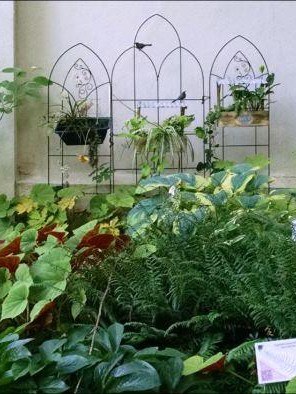Eye-Catching Appeal

Utility Garden
Explore and experience this enchanting garden that features low maintenance plants with appealing color, form, and texture. This eye-catching garden demonstrates creative ways to address functional and environmental issues and provides an interesting green buffer zone to soften the harshness of the house wall and the utilities' access points. The garden also offers many aesthetic pleasures and provides food, shelter, and water to attract and support wildlife.
Do you have an unsightly area around your home? Consider these creative solutions to address similar functional and environmental challenges.
Growing Conditions
The location of this garden on the North-facing wall of the Penn State Extension Offices in the Lewis' house presents many functional and environmental challenges:
- Heavy foot traffic to access utilities
- Dragging of an oil hose for oil deliveries
- An unsightly electrical panel
- Water, cable, and phone lines
- Water run-off from the drain spout and pavement
- Partial to heavy shade
- Sparse soil over a rocky bed
Description
A paperbark maple tree, which anchors the garden, has been pruned to allow more light penetration. A gray dogwood shrub camouflages the electrical panel. A red dogwood shrub located along the back visually breaks up the large expanse of blank house wall.
The field stone path provides attractive and functional utility access. The drain spout is buried for its protection and to improve visual appeal. Evergreen Lenten Rose lines the front and side of the stone path. This plant is sturdy and flexible enough to withstand the weight of snow plowed onto the garden perimeter. The garden also features a variety of colorful perennials, ground covers, and interesting ferns.
Garden enhancements include:
- A trellis adorned with household tropical plants in the summer and decorative wreaths with bird suet and berries in the winter
- Bird house and bird bath
- Custom plant signage using the art form, Zentangle
The garden is comprised of over 30 varieties of plants:
- 81% are deer tolerant
- 75% are native plants
- 62% tend to naturalize or form a mass that protects wildlife.
Background
Rejuvenation of the garden to address the functional and environmental challenges began in 2013. Perennials infested with goutweed and bindweed were removed and then replanted after the weeds were eradicated. The fieldstone pathway was laid and the drainpipe was buried. In 2014, the trellis was added to give dimension to the house's foundation. In 2015, plants for fall color and interest were added such as Hummingbird mint, coneflowers, and asparagus.
Featured Plants*
Ferns
- Matteuccia struthiopteris, Ostrich fern
- Polystichum acrostichoides, Christmas fern
Grass
- Muhlenbergia capillaris, Pink muhly grass
Herbaceous Plants
- Agastache 'Purple Haze', Hummingbird mint
- Asparagus officinalis 'Martha Washington', Asparagus
- Astilbe sp., White astilbe
- Begonia grandis, Hardy begonia
- Carex pensylvania, Pennsylvania sedge
- Coreopsis verticillata 'Bengal Tiger', Threadleaf
- Coreopsis verticillata 'Moonbeam", Threadleaf
- Echinacea x hybidus 'Supreme™ Cantaloupe', Coneflower
- Epimedium x versicolor, Bishop's hat
- Galium adoratum, Sweet woodruff
- Gillenia stipulata, American ipecac
- Helleborus foetidus, Stinking or bear's foot
- Helleborus x hybridus 'Red Lady', Lenten rose
- Heuchera x coral bells, Alum root
- Liriope spp., Lilyturf
- Lobelia cardinalis, Cardinal flower
- Lobelia siphilitiea, Blue lobelia
- Penstemon digitalis 'Husker Red', Beardtongue
- Phlox subulata 'Emerald Blue', Moss phlox
- Podophyllum peltatum, May-apples
- Polygonatum spp., Solomon's seal
- Sedum telephium 'Autumn Joy', Sedum
- Stylophorum diphyllum, Celandine wood poppy
Shrubs
- Aralia cordata 'Sun King', Mountain asparagus
- Cornus racemosa, Grey dogwood
- Cornus sericea, Red-osier dogwood
Tree
- Acer griseum, Paperbark maple tree
*This is not a comprehensive plant list. The garden is dynamic in nature and plants may vary from year to year.

